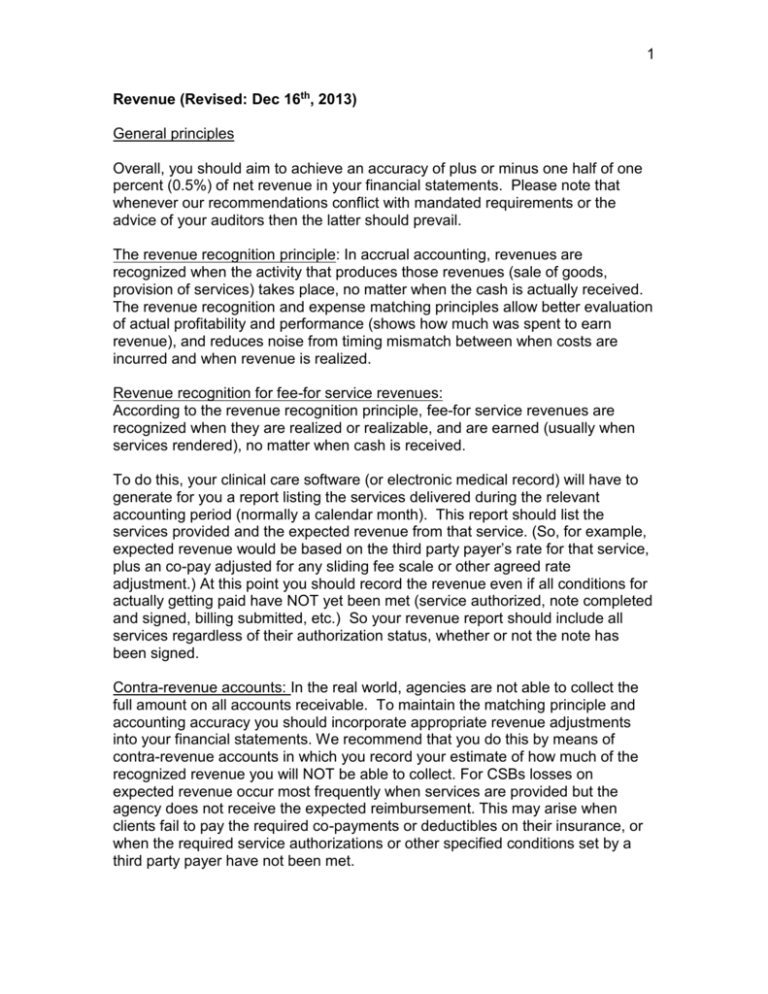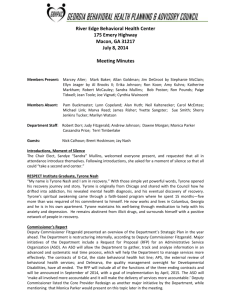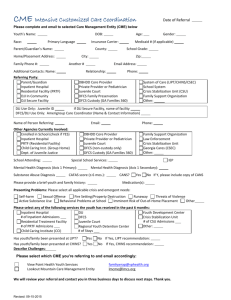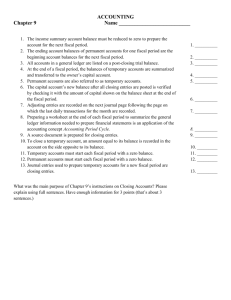Revenue Recognition-1
advertisement

1 Revenue (Revised: Dec 16th, 2013) General principles Overall, you should aim to achieve an accuracy of plus or minus one half of one percent (0.5%) of net revenue in your financial statements. Please note that whenever our recommendations conflict with mandated requirements or the advice of your auditors then the latter should prevail. The revenue recognition principle: In accrual accounting, revenues are recognized when the activity that produces those revenues (sale of goods, provision of services) takes place, no matter when the cash is actually received. The revenue recognition and expense matching principles allow better evaluation of actual profitability and performance (shows how much was spent to earn revenue), and reduces noise from timing mismatch between when costs are incurred and when revenue is realized. Revenue recognition for fee-for service revenues: According to the revenue recognition principle, fee-for service revenues are recognized when they are realized or realizable, and are earned (usually when services rendered), no matter when cash is received. To do this, your clinical care software (or electronic medical record) will have to generate for you a report listing the services delivered during the relevant accounting period (normally a calendar month). This report should list the services provided and the expected revenue from that service. (So, for example, expected revenue would be based on the third party payer’s rate for that service, plus an co-pay adjusted for any sliding fee scale or other agreed rate adjustment.) At this point you should record the revenue even if all conditions for actually getting paid have NOT yet been met (service authorized, note completed and signed, billing submitted, etc.) So your revenue report should include all services regardless of their authorization status, whether or not the note has been signed. Contra-revenue accounts: In the real world, agencies are not able to collect the full amount on all accounts receivable. To maintain the matching principle and accounting accuracy you should incorporate appropriate revenue adjustments into your financial statements. We recommend that you do this by means of contra-revenue accounts in which you record your estimate of how much of the recognized revenue you will NOT be able to collect. For CSBs losses on expected revenue occur most frequently when services are provided but the agency does not receive the expected reimbursement. This may arise when clients fail to pay the required co-payments or deductibles on their insurance, or when the required service authorizations or other specified conditions set by a third party payer have not been met. 2 We recommend that you should record the amount of revenue you expect NOT to receive in an account labeled as “Allowance for uncompensated care” which you then deduct from the total of recognized revenue. Your estimate of how much of the recognized revenue you will not be able collect will vary from payer to payer, and the efficiency of your agency’s personnel in meeting payers’ requirements. To estimate the allowance for uncompensated care you will need to look back over a period of time. The “look back period” should be long enough for the billing and payment process to be completed, and this will vary with payer. For many payers, this process is completed within 6 months, but keep in mind that Medicare and private insurance may take much longer to pay up. You should select a “look-back period” appropriate to your agency’s principal payers. As you review your historical data you will be able to calculate typical collection rates for each payer, and use these to estimate what you should record in the contra-revenue accounts for each accounting period. Allowance for uncompensated care: Debit -- Rev Acct – Uncollectible Accts – XXX Credit -- AR Acct - Allowance for Uncollectible Accounts - XXX Revenue from Grant-in Aid (aka State Contracted Services) As the name implies, revenue from State Contracted Services should be treated as a revenue contract, with the revenue recorded each month based on the Monthly Income and Expenditure Reports (MIERS). MIERS are submitted at the beginning of the month following the month of service; therefore revenue should be accrued as of the previous month (when it was earned) and a corresponding receivable established. MIERS Recognition: Debit Due from DBHDD Credit Revenue Payment for Services: Debit Cash Credit Due from DBHDD EXAMPLE: The contract with DBHDD for State Contract Services for a CSB is $12,000,000 for all services. The funds are drawn via submission of monthly MIERS. 3 In early August MIERS are submitted totaling $1,000,000 to draw the July contract funds. The following revenue entry should be recorded for July, prior to closing the books for July. Due from DBHDD $1,000,000 State Contract Revenue $1,000,000cr To record July SCS Revenue and related receivable When the cash is received, the following entry should be made in the month in which the cash is received: Cash Due from DBHDD To record payment of July SCS $1,000,000 $1,000,000cr Other Revenue Contracts Revenue from other contracts, such as for providing services in county jails, should be recorded based on the conditions of each particular contract (e.g., based on actual services provided, etc.) Revenue from county contributions and fund raisers These kinds of revenue are generally not tied to the delivery of any particular services, and to maintain the principle that financial statements should reflect the financial position of the agency it is recommended that they be accrued, but only if material (plus or minus one half of one percent (0.5%) of net revenue) Advances SCS contracts are paid in arrears each month, which causes a cash-flow challenge for CSBs. To provide for working cash flow, the practice of DBHDD has been to provide an advance to CSBs at the first of each fiscal year. These funds can be thought of as a no-interest loan to be repaid to DBHDD by the end of the fiscal year. Typically DBHDD offsets MIERS payments late in the fiscal year against the advance. A typical CSB contract advance should be considered as a current liability to be repaid within the fiscal year after all the services under the contract have been provided (usually at the end of the fiscal year/ the period covered by the advance Advances Received: (Initial journal entry) Debit Cash (Asset) Credit Due to DBHDD (Liability) 4 Advances Recouped: Debit Due To DBHDD (Liability) Credit Due From DBHDD (Asset) EXAMPLE: When the contract with DBHDD is executed in July, DBHDD agrees to advance $800,000 to the CSB. Cash $ 800,000 Due to DBHDD $ 800,000cr To record advance of funds from DBHDD (recorded when cash is received) In July of the following fiscal year, the MIERS for June are submitted and revenue is recognized as follows: Due from DBHDD $1,000,000 State Contract Revenue $1,000,000cr To record June SCS Revenue and related receivable DBHDD offsets the payment for June services against the outstanding advance balance. When the cash is received, the following entry should be made: Cash $ 200,000 Due from DBHDD $ 200,000cr To record cash payment of June SCS (reduced by outstanding advance balance) This leaves a balance of $800,000 in the Due from DBHDD account for June services. The Due to DBHDD (Advance) balance should be applied against the remaining Due from DBHDD account as follows: Due to DBHDD $ 800,000 Due from DBHDD $ 800,000cr To record the offset of the Advance against the June MIERS payment Questions of materiality Information is material if its omission or misstatement could influence the economic decisions of users taken on the basis of the financial statements (IASB Framework). Materiality therefore relates to the significance of transactions, balances and errors contained in the financial statements. Materiality defines the threshold or cutoff point after which financial information becomes relevant to the decision making needs of the users. Information contained in the financial 5 statements must therefore be complete in all material respects in order for them to present a true and fair view of the affairs of your agency. Materiality is relative to the size and particular circumstances of individual agencies. Our recommended accuracy of plus or minus one half of one percent (0.5%) of net revenue in your financial statements should help you determine whether or not particular information is material. You should consult with your auditor whenever you are uncertain about the materiality of information.




